
DATAMATH CALCULATOR MUSEUM
 |
DATAMATH CALCULATOR MUSEUM |
Texas Instruments TI-XXXXXXX (Voyage 200 Engineering Sample)
| Date of introduction: | Jan.6, 2002 | Display technology: | LCD dot matrix |
| New price: | $199.99 (SRP 2008) | Display size: | 12 lines by 40 char 128 * 240 pixels |
| Size: | 4.6" x 7.3" x
1.1" 117 x 185 x 27 mm3 |
||
| Weight: | 9.6 ounces, 272 grams | Serial No: | Engineering Sample 086 |
| Batteries: | 4*AAA + CR1616 | Date of manufacture: | mth 11 year 2001 |
| AC-Adapter: | Origin of manufacture: | Taiwan (I) | |
| Precision: | 14 | Integrated circuits: | CPU: MC68EC000 ASIC: TI-REF 200C040 Flash: LH28F320 RAM: 2* TC55V1001 Display: 3*T6B07, 2*T6B08 |
| Memories: | |||
| Program steps: | 188k Bytes, 2.7M Bytes Flash ROM | Courtesy of: | Joerg Woerner |
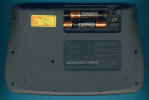
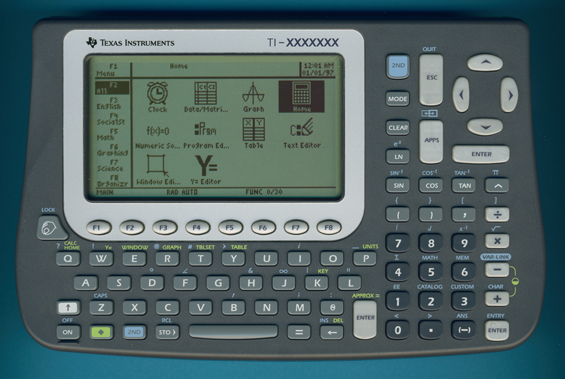
![]() We
recently were able to acquire this rare Engineering Sample of the
Voyage 200 Symbolic calculator with the interesting
nameplate TI-XXXXXXX. Dismantling the calculator reveals an almost 6 years old design in new
clothes!
We
recently were able to acquire this rare Engineering Sample of the
Voyage 200 Symbolic calculator with the interesting
nameplate TI-XXXXXXX. Dismantling the calculator reveals an almost 6 years old design in new
clothes!
We wrote January 5, 1996 when Texas Instruments released with the TI-92 their first Symbolic calculator using a powerful 16/32-bit microcomputer, a full ASCII keyboard, a wide graphics screen and tons of built in software. The TI-92 received since its introduction two upgrades:
TI-92 II: Language selectable Operating System and 128k Bytes additional User memory.TI-92 Plus: Flash ROM technology for re-programmable Operating System and downloadable applications.
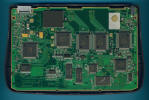 The printed circuit board
(PCB) of this early Voyage 200 Engineering Sample manufactured in November 2001 makes use of the TI-92 Plus hardware, but doubles the
capacity of the Sharp
LH28F320 Flash ROM from 1Mx16 bits (2M Bytes) to 2Mx16 bits (4M Bytes).
The printed circuit board
(PCB) of this early Voyage 200 Engineering Sample manufactured in November 2001 makes use of the TI-92 Plus hardware, but doubles the
capacity of the Sharp
LH28F320 Flash ROM from 1Mx16 bits (2M Bytes) to 2Mx16 bits (4M Bytes).
The main components of the Voyage 200 Engineering Sample manufactured in
November 2001:

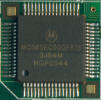 CPU
(Central processing Unit): The
Motorola MC68EC000
- the original M68000 16/32-bit microprocessor introduced in 1979 - optimized
for embedded applications is supported by the TI-REF 200C040 and replaces the Application
Specific CPU SC414181
solution if the TI-92. Learn more about the Hardware Architecture of TI’s Graphing Calculators.
CPU
(Central processing Unit): The
Motorola MC68EC000
- the original M68000 16/32-bit microprocessor introduced in 1979 - optimized
for embedded applications is supported by the TI-REF 200C040 and replaces the Application
Specific CPU SC414181
solution if the TI-92. Learn more about the Hardware Architecture of TI’s Graphing Calculators.
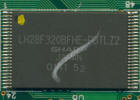 ROM (Read Only Memory): The ROM contains the operating
system of the calculator. The first products on the market used
mask-programmable ROM, the program was stored already during the production
of the Integrated Circuit. Later calculators changed to Flash ROM, a
technology allowing the programming of the software during the final production
stage of the calculator. With the TI-83 Plus and all later graphing calculators
from Texas Instruments even the user was able to reprogram the operating system.
ROM (Read Only Memory): The ROM contains the operating
system of the calculator. The first products on the market used
mask-programmable ROM, the program was stored already during the production
of the Integrated Circuit. Later calculators changed to Flash ROM, a
technology allowing the programming of the software during the final production
stage of the calculator. With the TI-83 Plus and all later graphing calculators
from Texas Instruments even the user was able to reprogram the operating system.
The
Flash ROM chip
LH28F320
of this Voyage 200
Engineering Sample was manufactured by Sharp, Japan. The capacity of the memory is 2Mx16
bits, or the equivalent of
4M Bytes.
![]() RAM
(Random Access Memory): The RAM is used as data memory and is used to store both
variables, user programs and intermediate results. This Engineering Sample
makes use of two Static RAM chips TC55V1001 manufactured by Toshiba, Japan. The capacity of the memory
chips is
128k Bytes, each.
RAM
(Random Access Memory): The RAM is used as data memory and is used to store both
variables, user programs and intermediate results. This Engineering Sample
makes use of two Static RAM chips TC55V1001 manufactured by Toshiba, Japan. The capacity of the memory
chips is
128k Bytes, each.
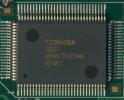 DISPLAY:
The Voyage 200 uses - in opposite to the handheld
graphing calculators from this era - display drivers in conventional packages.
We noticed in this Voyage 200 three T6B07
column drivers and two T6B08 row
drivers manufactured by Toshiba,
Japan.
DISPLAY:
The Voyage 200 uses - in opposite to the handheld
graphing calculators from this era - display drivers in conventional packages.
We noticed in this Voyage 200 three T6B07
column drivers and two T6B08 row
drivers manufactured by Toshiba,
Japan.
A serial port of the calculators allows the connection to the Calculator-Based
Laboratory system CBL, its successor CBL
2 and the Calculator-Based Ranger CBR. Texas
Instruments announced June 2002 an
optional full-sized QWERTY Keyboard for a more
convenient entry of notes into the handhelds but it even matched the
Voyage 200.
![]() Within
the long history of TI calculators between 1972 (the famous Datamath)
and today (June 2003) we never discovered a nameplate without the leading TI-xx designation.
Even the engineers of Texas Instruments were surprised when marketing decided
for the unusual Voyage 200 name!
Within
the long history of TI calculators between 1972 (the famous Datamath)
and today (June 2003) we never discovered a nameplate without the leading TI-xx designation.
Even the engineers of Texas Instruments were surprised when marketing decided
for the unusual Voyage 200 name!
Don't miss this TI-XXXXXXXXXXX,
you are right: 11 X vs 7 X.
ROM-Versions:
You can check the ROM version of your
Voyage 200 using the following key
sequence and reading the number on your screen:
[F1] [A]
Information provided by ticalc.org
and Xavier Andréani.
Exam acceptance:
Since the TI-92 Series and Voyage 200
feature a QWERTY keyboard they are not allowed on ACT,
SAT, PSAT
and AP exams.
If you have additions to the above article please email: joerg@datamath.org.
© Joerg Woerner, October 5, 2011. No reprints without written permission.